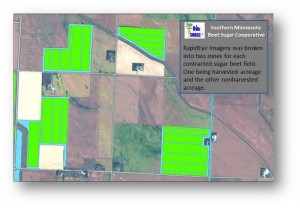The Southern Minnesota Beet Sugar Cooperative (SMBSC), based in Renville, Minnesota, utilized 5-meter 5-band RapidEye imagery purchased from Apollo Mapping to calculate the harvested acreage of sugar beet fields. This question and answer series was completed with Jody Steffel, Statistical Assistant, during April 2013.
Question 1: Can you provide me with an overview of your project, its duration and the study sites?
This study used 5-meter 5-band RapidEye imagery to predict harvested acres from multiple imagery dates for sugar beets in Minnesota. Our specific study site was in Central and Southwestern Minnesota and included 20 counties. The study spanned the fall of 2012 from August 28 to October 11. As seen in the image provided, fields with nonharvested acreage are colored bright green while bare ground or harvested acreage is blue.
Question 2: What groups were involved with this research project?
This project was completed by the Southern Minnesota Beet Sugar Cooperative and the information extracted from the RapidEye imagery benefitted all of our member growers. The SMBSC operates a grower-owned sugar factory that is located on a 1 square mile plot of land in south-central Minnesota. Construction of the plant started May 1973 and was originally designed to process 6,500 tons of sugar beets. Today, after several expansions, the plant can process 2.6 million tons of beets a year. These beets are grown on 119,259 acres of Minnesota land by 587 shareholders, covering an area that is 110 miles north to south and 100 miles east to west.
Question 3: How was satellite imagery used in this project?
Our project used satellite imagery to calculate the acreage of harvested (bare ground) versus nonharvested sugar beet canopy. This information allowed us calculate the difference of total acreage classified as bare ground from contracted total field acres to determine the acreage remaining to be harvested. This information, combined with up-to-date delivery records, allowed for an estimate of tons per acre before the sugar beet harvest was completed. These results helped to determine possible sugar beet pile heights at receiving stations and the final size of the crop to make the best management decisions possible.
Question 4: What technology and/or software packages were used to complete the geospatial analysis required for this project?
We utilized Esri’s ArcMap along with a customized tool built specifically for this project to calculate bare ground versus canopy. For infield testing, the geospatial layers, which included the RapidEye imagery along with the classified land cover vectors, were viewed on a GPS unit to verify the locations of the bare ground and canopy strips within the test fields.
Question 5: How did Apollo Mapping contribute to this project?
Apollo provided us with RapidEye satellite imagery in a timely and efficient manner, as well as expertise regarding the availability of other satellite products. We purchased 5-meter 5-band RapidEye imagery from Apollo Mapping at timed intervals, which included multiple tiles and dates, in order to cover key sections of our larger growing area.
Question 6: Could you tell us a bit about your experience working with the Apollo Mapping sales team?
Katie Nelson and Apollo Mapping provided exceptional service, going above and beyond in their efforts to provide information on available geospatial products and secure them for our use. This project was intended to be as close to ‘real-time’ as possible to support accurate harvest acreage predictions and final yield estimates. Katie worked very hard in providing us quick turn-around time from the moment the image was taken to the delivery of the product to us.



Leave a Reply